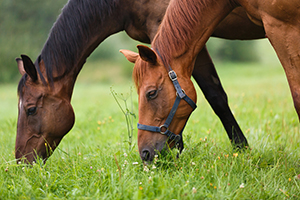Topical Wound Care for Horses
Sooner or later, it’s bound to happen. Your horse comes in with a wound that needs care and attention. Do you know the best first aid for your horse’s needs?

“A wound to your horse’s body can take the form of an abrasion, puncture or full thickness skin cut,” notes Dr. Glennon Mays, clinical associate professor at the Texas A&M College of Veterinary Medicine & Biomedical Sciences.
“The body has its own marvelous mechanisms for healing injured tissue,” states Mays. “Following the trauma, the body sends white blood cells to the injured site to clean up the damaged cells and fight infection. These white blood cells rid the wound of dead cells and bacteria. This expelling of non-viable cells can be seen as either a clear or slightly yellow discharge.”
The first thought at the sight of this oozing is to dry it up, however, the white blood cells need moisture to continue their healing work, explains Mays. If additional moisture is needed, an antibiotic topical ointment can be applied.
“The body also responds to the wound with inflammation,” notes Mays. “The cells that respond to the injured tissue do so to increase blood flow which facilitates clean up and repair of the wound. This extra flow of blood brings swelling, redness and heat to the injured area. Therefore, inflammation should be controlled but not suppressed.”
The body continues to remove contaminants while there is inflammation, explains Mays. As decontamination continues, cells that produce repair material move into the wound area. Then granulation tissue forms. Excessive granulation can result in “proud flesh” when the new tissue extends beyond the surface of the wound margins. Moisture does stimulate granulation and excessive moisture often results in “proud flesh” which prohibits continuation of the healing process. If the wound appears to have excessive granulation tissue, the aid of veterinary care is often needed.
“Wound treatment may include a combination of antibiotics to control infection, anti-inflammatory injections for pain management and ointments for wound medication,” notes Mays.
In treating any horse wound, the first step should be to clean the injured flesh, states Mays. Flushing the wound with water or saline solution will help remove dirt and bacteria from the cut. Saline solution can be made by dissolving two tablespoons of table salt in one gallon of distilled water. Wounds that are exceptionally dirty may need an antimicrobial wash which contains iodine. This wash will kill surface bacteria while cleansing the wound.
“Call your veterinarian if the wound is over a joint, involves bone/ligaments or pulls apart when your horse moves,” explains Mays. “A wound to your horse’s leg, especially near a joint where there is motion, should be referred to your veterinarian. If your horse receives a below-the-knee leg wound, it is best to seek medical assistance since leg tissue mass is limited and there can be contamination from dirt.”
Bandaging may not be necessary for some cuts and abrasions. However, leg wounds may need bandaging to reduce dirt contamination and skin motion so that healing can occur, notes Mays. A bandage keeps topical medication on the wound. Also, the light pressure of the bandage suppresses excess outgrowth of skin and promotes less scaring.
Small wounds may go undetected, cautions Mays. They may not be seen before contamination and infection occur. Since tetanus is always a threat, be sure that your horse receives a tetanus vaccination and stays current.
Horses are prone to injury. Knowing basic first aid treatments to care for a horse’s wound will allow you to assess the situation and determine the best treatment. The right medication administered at the proper time by the proper person can facilitate the natural healing process of your horse’s body.
Pet Talk is a service of the College of Veterinary Medicine & Biomedical Sciences, Texas A&M University. Stories can be viewed on the Web at vetmed.tamu.edu/news/pet-talk. Suggestions for future topics may be directed to editor@cvm.tamu.edu.


